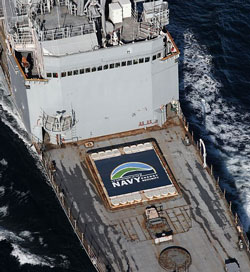The U.S. Navy successfully concluded the largest demonstration of shipboard alternative fuel use last week when the Self Defense Test Ship (SDTS) arrived on November 17 at the Naval Surface Warfare Center Port Hueneme, Calif.
 The SDTS is a decommissioned Spruance-class destroyer ex-Paul F. Foster (EDD 964) reconfigured to provide the Navy an at-sea, remotely controlled, engineering test and evaluation platform without the risk to personnel or operational assets.
The SDTS is a decommissioned Spruance-class destroyer ex-Paul F. Foster (EDD 964) reconfigured to provide the Navy an at-sea, remotely controlled, engineering test and evaluation platform without the risk to personnel or operational assets.
The ship received approximately 20,000 gallons of a 50-50 blend of an algae-derived, hydro-processed algal oil and petroleum F-76 from the Defense Fuel Supply Point at Naval Base Point Loma on Nov. 16 and then traveled 17 hours to Port Hueneme on the fuel. According to the Navy, 100 percent of ship’s propulsion power and 50 percent of service power came from the algal oil/F-76 fuel blend.
“How can we have an impact?” asked Assistant Secretary of the Navy (Energy, Installations and Environment) Jackalyne Pfannenstiel at the demonstration’s kick-off. “We can have an impact as a technology leader, highlighting and demonstrating the viability of biofuels.”
Meeting the secretary of the Navy’s call for a drop-in fuel replacement, no changes were required to the infrastructure of the ship or fueling pier for the SDTS test. “From our perspective as the ship’s operators, there was absolutely no difference, whatsoever, in the operation or performance of the ship,” said Mike Wolfe, Naval Surface Warfare Center Port Hueneme Division underway project officer. “The fuel burned just like the traditional fuel we get from the Navy and have been burning for years. We could not tell the difference. The biggest success is that a Navy ship with engines identical to those in commissioned warships operated successfully on an overnight transit with the alternative fuel without a glitch in anything. Operationally, it was absolutely a success.”
The alternative fuels effort supports the Navy’s overall energy strategy to increase energy security and safeguard the environment.

